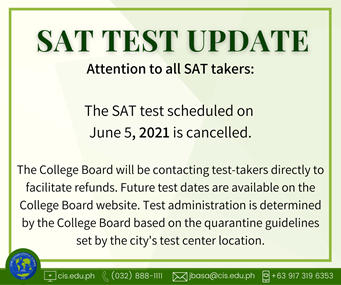
Admin News
by Dr. Gwyn Underwood, Superintendent
Dear CIS Community,

I am extremely pleased to share with you that we have now received our official letter of authorization from the International Baccalaureate (IB), and are officially authorized to offer the Middle Years Programme (MYP)!
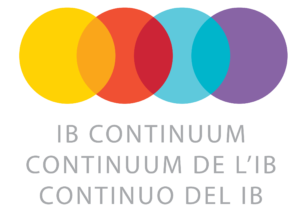
The addition of the MYP to the IB Primary Years Programme (PYP) in our elementary school and the Diploma Programme (DP) in grades 11-12 enables us to offer a seamless IB education throughout our Early Years-Grade 12 program. CIS now joins an elite group of IB Continuum Schools worldwide (IB World School which offers at least three of the four available IB programs). We are also the first and only IB Continuum school in the Philippines!
Congratulations to any of you who have contributed to this milestone in any way. We want to publically thank Mr. Jonathon Denton, our Assistant Principal-MYP, for effectively coordinating the implementation process over the last two years, and we recognize all of the work our MYP teachers have put into adapting to the MYP standards and practices. We are excited at the contributions the MYP will make to our provision of a high-quality education for our students.
Upcoming events and dates for your attention
- Parents, please join our last Parent Coffee Meeting next Tuesday, May 25 at 9-10 am. This time is provided to enable you to chat with fellow parents, receive news details directly for the admin team members, and discuss parent-related issues.
- May 26 Wed: Whole School Celebration of Learning (virtual – details will be provided by the divisional principals. Students, note this day is not included on our day rotation so Thu will be Day B!)
- May 28: Class of 2021 Graduation Ceremony (virtual)
- Refer to our online School Calendar a complete listing of school events
Have a safe, restful weekend!
Elementary News
by Mr. Glenn Davies, Elementary School Principal
Celebration of Learning
This coming Wednesday, May 26th, is the CIS Celebration of Learning event. This is a significant event in the CIS school Calendar when all students have the opportunity to demonstrate the growth they have made in their skills, knowledge, and personal attributes during the school year.
 This week the students have been working with their teachers to design their Celebration of Learning Day so that each learning from each subject area can be represented. The CIS PYP Curriculum is designed to prepare students for a rapidly changing world, one where the traditional realms of knowledge and skill become quickly outdated. In order to prepare students for this world the curriculum places considerable emphasis on How to Learn, not just What to Learn. As parents who experienced a different kind of education, we sometimes struggle with this difference, because our children take a little longer to master some of the knowledge components of the curriculum. This is because we learned in a system that placed high levels of value on memorisation, viewing the ability to rapidly recall relatively simple pieces of factual information quickly. At CIS we recognise that it can be useful to recall such knowledge quickly at times, however we also recognise that the ability to know how to locate information, organize and interpret this information, and apply it to an unfamiliar context is of much greater value. Because we cannot teach everything of importance, this is where the focus must lie for a school who wishes to prepare students for a rapidly changing world. The Celebration of Learning is an opportunity for your children, our students, to demonstrate this type of learning growth.
This week the students have been working with their teachers to design their Celebration of Learning Day so that each learning from each subject area can be represented. The CIS PYP Curriculum is designed to prepare students for a rapidly changing world, one where the traditional realms of knowledge and skill become quickly outdated. In order to prepare students for this world the curriculum places considerable emphasis on How to Learn, not just What to Learn. As parents who experienced a different kind of education, we sometimes struggle with this difference, because our children take a little longer to master some of the knowledge components of the curriculum. This is because we learned in a system that placed high levels of value on memorisation, viewing the ability to rapidly recall relatively simple pieces of factual information quickly. At CIS we recognise that it can be useful to recall such knowledge quickly at times, however we also recognise that the ability to know how to locate information, organize and interpret this information, and apply it to an unfamiliar context is of much greater value. Because we cannot teach everything of importance, this is where the focus must lie for a school who wishes to prepare students for a rapidly changing world. The Celebration of Learning is an opportunity for your children, our students, to demonstrate this type of learning growth.
There will be three parts to the Celebration of Learning in the Elementary school on Wednesday.
Student-Led Conference: Firstly, your children will prepare a series of learning engagement demonstrations to share with you at home. We ask that you set aside the necessary time on Wednesday. If you are unable to spend this time with your child on Wednesday, please ensure you commit another time in the week or weekend when this will be made a priority.
Three-Way Conference: Early this week you received an invitation to sign up for a Three-Way Conference. This conference is an opportunity for your child, the teacher and yourself to discuss the progress made over the semester, review your child’s personal goals, and together identify future areas for growth.
Follow-up Specialist Learning Engagements: During the Celebration of Learning there will be no formal classes or regular synchronous calls. Each class will have two specialist learning engagements to complete on this day following the SLC and 3WC. Following the completion of the sections listed above, please have your child visit Seesaw to complete the Celebration of Learning Specialist learning engagements.
We do encourage you to ask your child about their Celebration of Learning plans so you are aware of what they are preparing. Please contact your child’s homeroom teacher if you have any questions.
Learning In Grade 5
With the school year drawing to a close, it is a significant time for the Grade 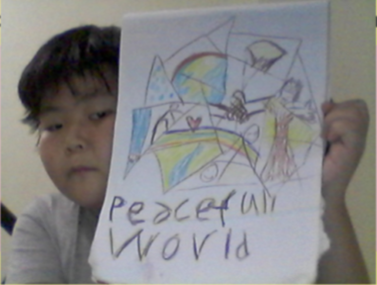 5 students as they finish their education in Elementary School and prepare to transition to Middle High School.
5 students as they finish their education in Elementary School and prepare to transition to Middle High School.
Earlier this month, the students showcased their learning through the Virtual PYP Exhibition (PYPx). If you have not already done so, please visit the website and leave a comment.
The PYPx is designed as a learning journey for the culmination of elementary school. It is an opportunity for students to demonstrate the ATL skills and Learner Profile attributes developed over the years.
The students selected a United Nations Sustainable Development Goal (SDG), then formed teams, centered around their interests and passions. They demonstrated their thinking skills through developing their own Lines 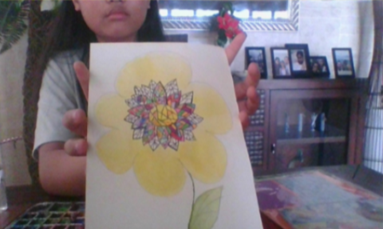 Of Inquiry and Key Questions, then employed their research skills through in-depth inquiries into their Central Idea.
Of Inquiry and Key Questions, then employed their research skills through in-depth inquiries into their Central Idea.
Students were supported by a wonderful team of mentors (thank you to Mr. Sten Coppin, Mr. Glenn Davies, Ms. Leanne Gibson, Ms. Mau Juanson, and Mrs. Aimee Underwood for the time and effort you invested on the students.)
Students collaborated in their teams to create a visual presentation of their key ideas, and conduct an online live presentation to an audience. This was quite intimidating for some students, but they proved themselves risk- takers and knowledgeable communicators through capably conducting their live sessions.
takers and knowledgeable communicators through capably conducting their live sessions.
Reflection after the PYPx revealed that all students felt they had benefited from the experience, with greater insight into their strengths, a better understanding of their chosen SDG and action they can take, and appreciation of areas for personal growth to continue their development as learners. The students agreed it was helpful in their preparation for Middle School.
Our current Unit Of Inquiry centers around the theme: The human body is made up of interrelated systems that change and affect people at different life stages. We have been investigating the form and function of different body systems and how they are connected. Collaborative groups have each studied a specific body system. They will be passing on their new knowledge and understanding to teach their fellow classmates in the coming days.
As we consider our bodies, we are gaining an appreciation of the many changes occurring within us right now. (physical, emotional, mental, social, spiritual, etc) For each person, the timing is different, and it is important that we understand the process of puberty, and treat each other with respect and care.
If you are a Grade 5 parent, you are probably noticing some of the changes the students have indicated:

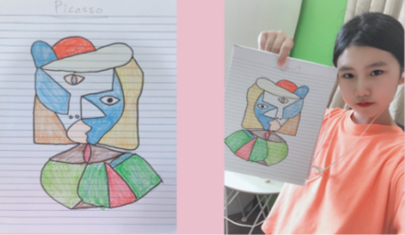 In other fields of learning, specifically in Arts, they are reading up about Cubism. Cubism was a revolutionary new approach to representing reality invented in around 1907–08 by artists Pablo Picasso and Georges Braque. They brought different views of subjects (usually objects or figures) together in the same picture, resulting in paintings that appear fragmented and abstracted.
In other fields of learning, specifically in Arts, they are reading up about Cubism. Cubism was a revolutionary new approach to representing reality invented in around 1907–08 by artists Pablo Picasso and Georges Braque. They brought different views of subjects (usually objects or figures) together in the same picture, resulting in paintings that appear fragmented and abstracted.
Learning in the Early Years
Story Workshop
 The Early Years participated in our story workshop and drew inspiration from the stories read during library classes. Having a story workshop process helped these young learner to develop their writing skills. They were able to build stories using different materials. The EYs made use of their imagination, life experiences and other familiar stories to create their own stories.
The Early Years participated in our story workshop and drew inspiration from the stories read during library classes. Having a story workshop process helped these young learner to develop their writing skills. They were able to build stories using different materials. The EYs made use of their imagination, life experiences and other familiar stories to create their own stories.
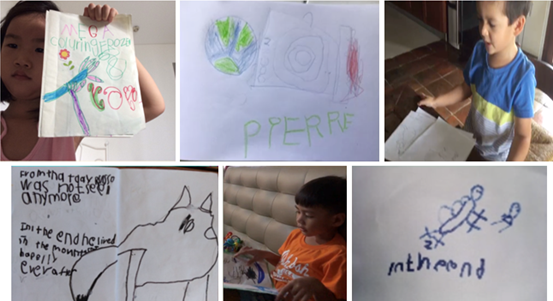 As they continued with the process, they managed to identify the characters, settings, and plot of their stories by using the transition words. At the end of the week, our young writers shared their stories in small groups and their stories were published in our Seesaw blog to allow others to share their friends’ stories and give comments or feedback.
As they continued with the process, they managed to identify the characters, settings, and plot of their stories by using the transition words. At the end of the week, our young writers shared their stories in small groups and their stories were published in our Seesaw blog to allow others to share their friends’ stories and give comments or feedback.
As we engaged in listening to the story, “So light, so heavy” shared with us by Ms. MJ, the author used seesaw as a tool for readers to explore the 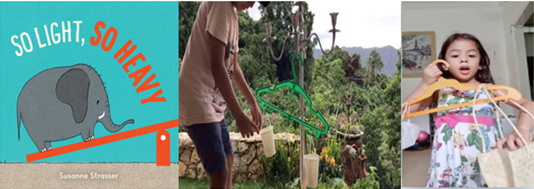 concept of heavy and light which allowed us to dive deeper and discover how heavy or light objects are. In math, our young learners made their own balancing scale to describe and explain their understanding of the concepts heavy and light. Now that we have a better understanding of the concepts heavy and light, we started to compare the length and weights of objects.
concept of heavy and light which allowed us to dive deeper and discover how heavy or light objects are. In math, our young learners made their own balancing scale to describe and explain their understanding of the concepts heavy and light. Now that we have a better understanding of the concepts heavy and light, we started to compare the length and weights of objects.
 Our youngest learners continued learning about the concepts of long and short as well as the concept of more or less by demonstrating simple measuring experiments. The Early Years showed their understanding of the math concepts by using different objects as a tool to measure and compare things. They demonstrated and shared their knowledge of the concept of capacity and concluded that containers can hold different things based on their size and shape.
Our youngest learners continued learning about the concepts of long and short as well as the concept of more or less by demonstrating simple measuring experiments. The Early Years showed their understanding of the math concepts by using different objects as a tool to measure and compare things. They demonstrated and shared their knowledge of the concept of capacity and concluded that containers can hold different things based on their size and shape.
Family Traditions Show and Tell
 As we continue with our unit on Where We Are In Place and Time, The Early Years collected some items that represented their families and traditions. They started to build on their understanding of where and how family traditions began by sharing some items from their families and the countries where they are from. As we are about to end our unit, we continue to inquire into the concept of Responsibility and we learn, respect, acknowledge and understand other families’ traditions.
As we continue with our unit on Where We Are In Place and Time, The Early Years collected some items that represented their families and traditions. They started to build on their understanding of where and how family traditions began by sharing some items from their families and the countries where they are from. As we are about to end our unit, we continue to inquire into the concept of Responsibility and we learn, respect, acknowledge and understand other families’ traditions.
Middle and High School News
by Mr. Dale Wood, Middle & High School Principal
Grade 5 Transition
An exciting initiative that we started two years ago and are continuing this year is our Grade 5 transition/mentoring program. This was an exciting initiative that came about through a collaboration between the ES and MHS, together with the counseling office, to help our Grade 5 students transition more successfully into our Middle Years Program. We have created a series of events and activities to help build the relationships between each student and his or her MHS mentor and also prepare the Grade 5 students with experiences to help them feel more at ease and prepared as they enter Grade 6 and the MYP Program.
Last week we invited our Grade 5 students to “come and try” our Grade 6 classes by joining them virtually. A small group of students each day had the opportunity to join at least 2 of our Grade 6 classes that day in order to get a better sense of what classes and structures in MYP were like.
We have also planned a series of weekly transition activities to help students connect with us and with their MHS mentors. For example, this week the Grade 5 students will take part in an Escape Room activity, created by Mr. Denton, where the clues needed to escape with their group are all related to MHS life, teachers, and classes.

On Tuesday afternoon, we also held a Transition Talk for our Grade 5 parents to better acquaint them with MHS and specifically the MYP program. Again, the transition team worked collaboratively both to create and deliver this presentation. Some of the key aspects that we discussed with parents were as follows:
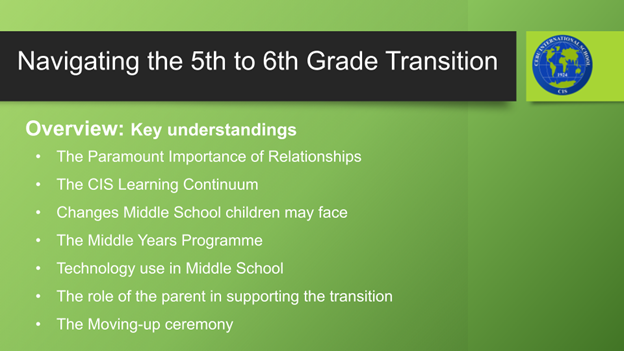

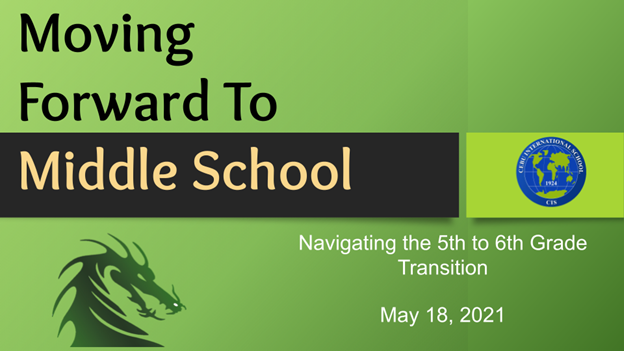
We have once again paired all of our rising 6th graders with a MHS mentor who will connect with them over the next few months and help them with the transition next year. Our mentors are a group of outstanding students who had to apply for the role and were hand-picked to mentor specific students in the rising 6th grade class. They serve as a resource for the Grade 6 students, providing help, guidance, wisdom, and accountability.
Maths Personal Project
Discovering maths through games and puzzles
When students in Grade 10 select the focus of their MYP Personal Project, a few brave souls choose to challenge themselves with exploring a subject like Math. On the surface “The Tower of Hanoi “ is an entertaining puzzle, accessible to a wide range of students. This year it became the focus for Thomas Kim for his MYP Personal Project. Throughout the year, Thomas has invested the time to dig deeper into this problem, discovering for himself how to sum a geometric series, the concept of recursion, and how a physical situation can be better represented in a binary base.
One at a time, he could have learnt about these topics in the classroom; instead, as any true mathematician appreciates, he has discovered that mathematics is not a succession of disparate topics but a connected whole. His success in this guided exploration reinforces his connection with mathematics and it has given him the confidence and motivation to aim higher. Who knows where this journey will take him?
Here are Thomas’ own words concerning his project:
Hello, my name is Thomas from Grade 10A. For my personal project, I chose to work on math. Most students feel math is scary and stressful. Often this is because of the ambiguity of the use of math in a real-life situation. People think that the calculation of real numbers is only knowledge used in the real-life. However, other mathematical theories also apply in real-life situations, such as the Tower of Hanoi.

The Tower of Hanoi is a mathematical puzzle consisting of three rods and multiple disks of different sizes that can be inserted and removed anywhere on the rods. The player should play the game according to these rules. 1. At first, all disks are stacked sequentially with small ones facing up on the left rod. 2. One disk can be moved to another rod at a time. 3. Large disk cannot be placed on a small disk. Regardless of three simple rules, there are numerous mathematical patterns. Now, let’s explore those patterns and disclose the answer from the unknown monk.
The recurrence relation is one of the solutions to find the number of movements. f(n) = 2 n – 1, n ∊ N, is the minimum number of movements needed. This formula is induced by a theory called recursion. It means calling its function inside the function itself. Now, let’s define a function as function f. A number of disks should be inserted into the domain and the range will represent the number of disks. For step 1, the number of movements is f(n-1). For step 2, only 1 movement is required. For step 3, we also need f(n-1) movements. If we add up all the ranges, the result will be f(n). So, a recurrence relation that expresses the number of disks is f(n) = 2{f(n-1)} + 1. If we transform this equation.
f(n)+1 = 2{f(n-1)+1}
f(n-1)+1 = 2{f(n-2)+1}
f(n-2)+1 = 2{f(n-3)+1}
…
f(2)+1 = 2{f(1)+1}
Multiply Both Sides
(f(n)+1)(f(n-1)+1)(f(n-2)+1)…(f(2)+1) = 2n-1{f(n-1)+1}{f(n-2)+1}{f(n-3)+1}…{f(1)+1}
Divide Both Sides By (f(n-1)+1)(f(n-2)+1)…(f(2)+1)
(f(n)+1) = 2n-1*{f(1)+1}
Set f(1) Into 1
(f(n)+1) = 2n-1*{21} = 2n
∴ f(n) = 2n-1
As you can see, there is a mathematical theory hidden inside one simple puzzle. Accordingly, we need to look for the interaction between scientific principles and human society to understand how the natural world works. I hope everyone will be able to understand the global context of “Scientific and technical innovation” throughout mathematical thinking.
Language & Literature 10
by Mr. Corryn Smith, Language & Literature Teacher
In their final quarter of Grade 10 Language & Literature, students are studying various genres of film & commercials (PSA’s, consumer advertisements, movie trailers and political attack ads) to better understand the purpose and structure of non fiction texts and how producers use these texts to appeal to their audiences.
As a final assessment of their understanding of these concepts, students have been tasked with creating their own film/commercial spot (Media Presentation) to demonstrate such structural aspects of film as camera angles and shots, montage, voice over, composition, lighting, make up and pacing.
In the student sample here from last year’s Grade 10, you’ll see a creative exploration of the PSA (Public Service Announcement) addressing issues of teen depression:
Grade 9A Visual Arts Class
by Ms. Gerri Ancajas Jumao-as, Visual Arts Teacher
The Grade 9A class are working on their unit ‘Still Life Portrait’. They are developing their drawing skills and addressing the key concept of form by looking at perspective and how objects can be arranged to lead to multiple representations (related concept).
Here are some students’ documentation of their progress.
It felt very difficult when drawing details, especially money. The painting in the money was very complicated and elaborate. What I drew doesn’t match the actual money, but I did my best and I’m satisfied with the result. I started coloring, but I quickly modified the iPhone sound and power button during coloring. I was very satisfied because the color of the cell phone was well added with the tonal value. – Minseong

I feel that, generally, the background needs more work at this point. The forms are all put in, but if I colored it now there would just be a lot of blank color, and while with a lot of shading and work with tonal value that could look good, I still want to provide a reason to look at the middle piece other than just it’s placement. To address the problem of the wide expanses, I’m thinking of adding a scenic background to the computer screen. – Zeke

I think that I developed my overall art skills and thinking because before I didn’t even bother with shading and these format compositions. This helped me arrange my thoughts and gave me better ideas when I wanted to draw, especially in art class. After the formative tasks and the 4 study drawing tasks, I do feel a bit more confident in drawing. – Clark

After all of the formative tasks, I think I’m a little bit more confident, not in the drawing part but in the item placement because I was able to figure out how to place different items on the drawing and how to overlap them if needed. Before it really took me a long time to figure out how to overlap each of the items while I was drawing, but now it’s a little easier to see which parts of the items I should cut off and which parts should stay. – Natalie

After the formative tasks and the 4 study drawing tasks, I am more confident in drawing this because I have drawn something similar before and I have drawn the objects multiple times. My confidence grew because I remember how to draw the objects and now I am already used to drawing them. That is why I find it so much easier to draw the objects. – Liam

Because I did the study beforehand, I was able to understand the importance of a good composition better. I did not expect this to have such an impact on my final choice. From the study, I chose to do the triangle composition since out of all my photos this, to me, created the most pleasing interest. – Sofia
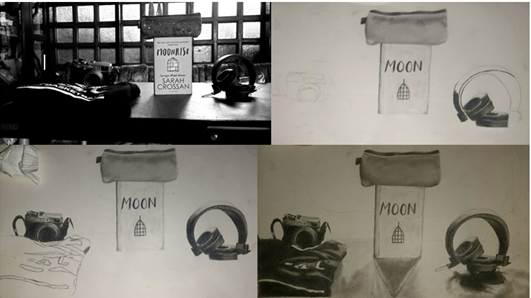
I used colored pencils for the paint tube because of the details and size of the object. I think I can try using the oil pastels for the background, cloth and maybe parts of the book. I really felt more confident drawing and coloring this piece because of all the exercises we have done in class. Now, I know how to use the color pencils better, as well as other tools that I have at home that have been of great use to me. I think I made lots of good progress today; I finished coloring in one whole object, and I have a relatively good plan in mind on how to fill in the rest of the image. – Mahati
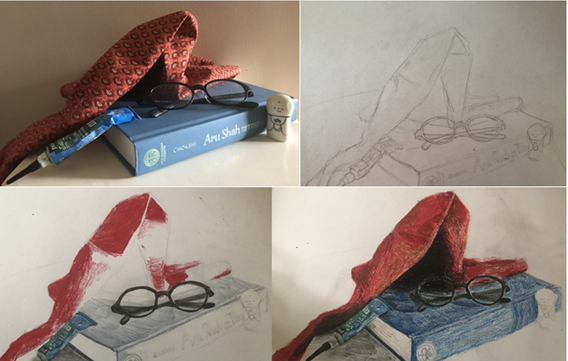
I started doing a bit of shading, it was a bit easier to do the drawings on a bigger piece of paper because there was more room and I had more space to draw the background. I like how it looks right now; it was really fun to see how the drawing improved after a couple times. I drew the table underneath so it would look more like the picture I took. – Sealoa
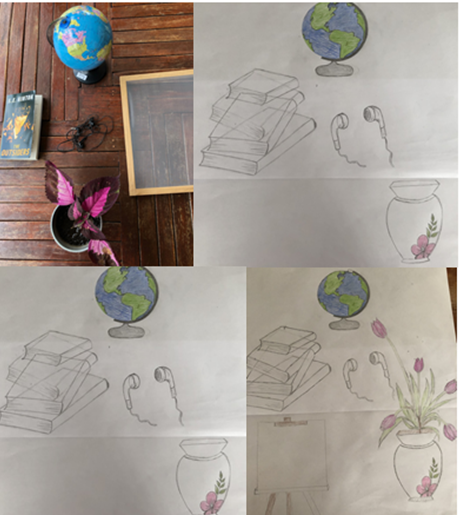
During this summative task, I feel like I’ve improved in adding tonal value with colored pencils. In the formative tasks it was hard for me to blend different shades of the same color together but I think I applied that really well when coloring the statue. Overall, this session was mainly for me to get some of the small objects and details colored in so that in the next two sessions, I could focus more on finishing the wallet, timer, and adding some shading to the background. – Esther

College/Careers Counselor Corner
by Ms. Jenny Basa, College/Careers Counselor Corner
Tip for the Week: Are you interested in studying in Europe?
If you are interested in studying in Europe, below are links to country-specific websites that can provide you with general information about universities, degrees offered, the application process and relevant information.
Resource link per Country
Austria – www.studyinaustria.at
Belgium – www.studyinbelgium.be/en
Bulgaria – www.studyinbulgaria.com
Croatia – www.studyincroatia.hr
Cyprus – www.studyincyprus.org.cy
Czech Republic – www.studyin.cz
Denmark – www.studyindenmark.dk
Estonia – www.studyinestonia.ee
Finland – www.studyinfinland.fi
France – www.campusfrance.org/en
Germany – www.daad.de/en
Greece – www.studyingreece.edu.gr
Hungary – www.studyinhungary.hu
Ireland – www.educationinireland.com
Italy – www.studyinitaly.it
Latvia – www.studyinlatvia.lv
Lithuania – www.studyin.lt
Luxembourg – www.luxembourg.public.lu/en/work-and-study/studying-in-luxembourg.html
Malta – www.integration.gov.mt/en/Education/Pages/Education-In-Malta.aspx
The Netherlands – www.studyinholland.nl
Norway – www.studyinnorway.no
Poland www.studyinpoland.pl
Portugal www.study-research.pt
Romania www.studyinromania.gov.ro
Slovakia www.studyinslovakia.sk
Slovenia www.studyinslovenia.si
Spain – www.studyinspain.info/en
Sweden – www.studyinsweden.se
Switzerland – www.studyinswitzerland.plus
Upcoming Virtual Events and Fairs: (students & parents are welcome)
DATE
May 22 & 23
Saturday & Sunday
1:30 PM – 5:00 PM
May 29 Saturday
3:30PM – 7:00 PM
